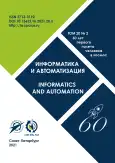Fast pupil tracking based on the study of a boundary-stepped image model and multidimensional optimization Hook-Jives method
- Authors: Grushko Y.V1, Parovik R.I1
-
Affiliations:
- Kamchatka State University named after Vitus Bering
- Issue: Vol 20, No 2 (2021)
- Pages: 435-462
- Section: Artificial intelligence, knowledge and data engineering
- URL: https://journal-vniispk.ru/2713-3192/article/view/266309
- DOI: https://doi.org/10.15622/ia.2021.20.2.7
- ID: 266309
Cite item
Full Text
Abstract
About the authors
Y. V Grushko
Kamchatka State University named after Vitus Bering
Email: neuralpill@gmail.com
Pogranichnaya St. 4
R. I Parovik
Kamchatka State University named after Vitus Bering
Email: romano84@mail.ru
Pogranichnaya St. 4
References
- Masrori P., Van Damme P. Amyotrophic lateral sclerosis: a clinical review. // European journal of neurology. 2020. vol. 27. pp. 1918-1929.
- Yang Zheng, Fu Hong, Li Rim, Lo Wai-Lun, Chi Zheru, Feng David, Song Zongxi, Wen Desheng. // Intelligent Evaluation of Strabismus in Videos Based on an Automated Cover Test. Applied Sciences. 2019.
- Swirski. L. Bulling. A. Dodgson. N. Robust real-time pupil tracking in highly off-axis images. // Proceedings of the Symposium on Eye Tracking Research & Applications (ETRA). 2012. pp. 173–176.
- Utaminingrum Fitri, Prasetya Renaldi, Arum Sari Yuita. Image Processing For Rapidly Eye Detection Based On Robust Haar Sliding Window. // International Journal of Elec-trical and Computer Engineering. 2017. vol. 07.
- Durna Yilmaz, Ari Fikret. Design of a Binocular Pupil and Gaze Point Detection System Utilizing High Definition Images. // Applied Sciences. 2017. vol. 7. 498.
- Грушко Ю.В. Аппаратно-программный комплекс аугментативной системы коммуникации на основе технологии Eyetracking. // Вестник КРАУНЦ. 2019. № 27:2. C. 55–73.
- Bonteanu Petronela, Cracan Arcadie, Bonteanu Gabriel, Bozomitu Radu. A Robust Pu-pil Detection Algorithm Based on a New Adaptive Thresholding Procedure. // IEEE International Conference on e-Health and Bioengineering EHB. 2019.
- Матвеев И.А. Методы и алгоритмы автоматической обработки изображений радужной оболочки глаза. Диссертация на соискание ученой степени доктора технических наук. 2014.
- Bozomitu Radu, Pasarica Alexandru, Lupu Robert, Rotariu Cristi, Coca Eugen. Pupil detection algorithm based on RANSAC procedure. // International Symposium on Sig-nals, Circuits and Systems (ISSCS). 2017. pp. 1-4.
- Li Dongheng, Winfield D., Parkhurst D.J. Starburst: A hybrid algorithm for video-based eye tracking combining feature-based and model-based approaches. // Paper Presented at the IEEE Computer Society Conference on Computer Vision and Pattern Recogni-tion. 2005. vol. 3. p. 79.
- Fuhl Wolfgang, Santini Thiago, Kübler Thomas, Kasneci Enkelejda. ElSe: ellipse se-lection for robust pupil detection in real-world environments. // The Ninth Biennial ACM Symposium. 2016. pp. 123-130.
- Mohammed Ghassan, Hong Bingrong, Alkazzaz Ann. Accurate Pupil Features Extrac-tion Based on New Projection Function. // Computing and Informatics. 2010. vol. 29. pp. 663-680.
- Лукошков И.А., Артемова А.А., Белов Ю.С. Адаптивный алгоритм нахождения границ зрачка на изображении. // Научное обозрение. Технические науки. 2020. № 3. C. 19-23.
- Матвеев И.А. Поиск центра радужки на изображении методом Хафа с двумерным пространством параметров. // Известия Российской академии наук. Теория и системы управления. 2012. № 6. С. 44-51.
- Alkuzaay Maryim, Alshemmary Ebtesam. Towards Accurate Pupil Detection Based on Morphology and Hough Transform. // Baghdad Science Journal. 2020. vol. 17(2). pp. 583-590.
- Ершов Е.И. Быстрое преобразование Хафа как инструмент анализа двумерных и трехмерных изображений в задачах поиска прямых и линейной кластеризации. Диссертация на соискание ученой степени кандидата физико-математических наук. 2018.
- Bresenham J. Algorithm for Computer Control of a Digital Plotter. // IBM Syst. J. 1965. vol. 4, pp. 25-30.
- Zongli Shi. Graphics Programming Principles and Algorithms. 2017.
- Rafael C. Gonzalez, Richard E. Woods. Digital image processing 4th. 2019. 1104 c.
- D. Marr, E. Hildreth. Theory of edge detection. // M.I.T. Psychology Department and artificial Intellegence Laboratory. 1980. pp. 187-217.
- Ansari Mohd, Kurchaniya Diksha, Dixit Manish. A Comprehensive Analysis of Image Edge Detection Techniques. // International Journal of Multimedia and Ubiquitous En-gineering. 2017. vol. 12. pp. 1-12.
- Robert Hooke, T.A. Jeeves. Direct Search Solution of Numerical and Statistical Prob-lems. // Westinghouse Research Laboratories, Pittsburgh, Pennsylvania. 1961.
- Медынский М.М., Дьячук А.К. Численные методы оптимизации с использованием MAPLE 11: Учебное пособие. – М.: Изд-во МАИ-ПРИНТ. 2009.
- Chinese Academy of Sciences Institute of Automation. Iris image database, version 4. URL: http://www.cbsr.ia.ac.cn/china/Iris20Databases20CH.asp. (accessed 2010).
- Mompeán J., Aragón J.L., Prieto P.M. et al. Design of an accurate and high-speed bin-ocular pupil tracking system based on GPGPUs. // J Supercomput. 2018. vol. 74. pp. 1836–1862.
- Ashraf Darwish. Bio-inspired computing: Algorithms review, deep analysis, and the scope of applications. // Future Computing and Informatics Journal. 2018. vol. 3. pp. 231-246.
Supplementary files









